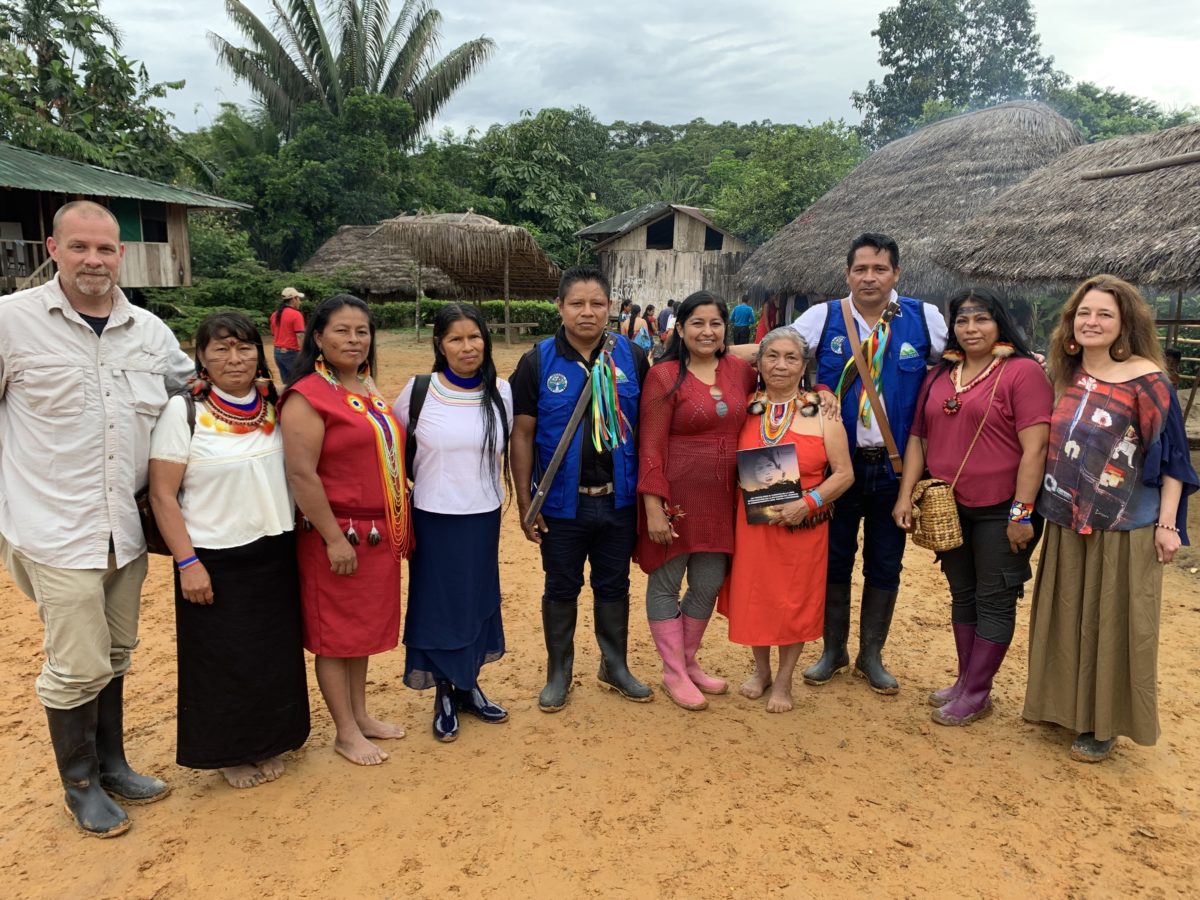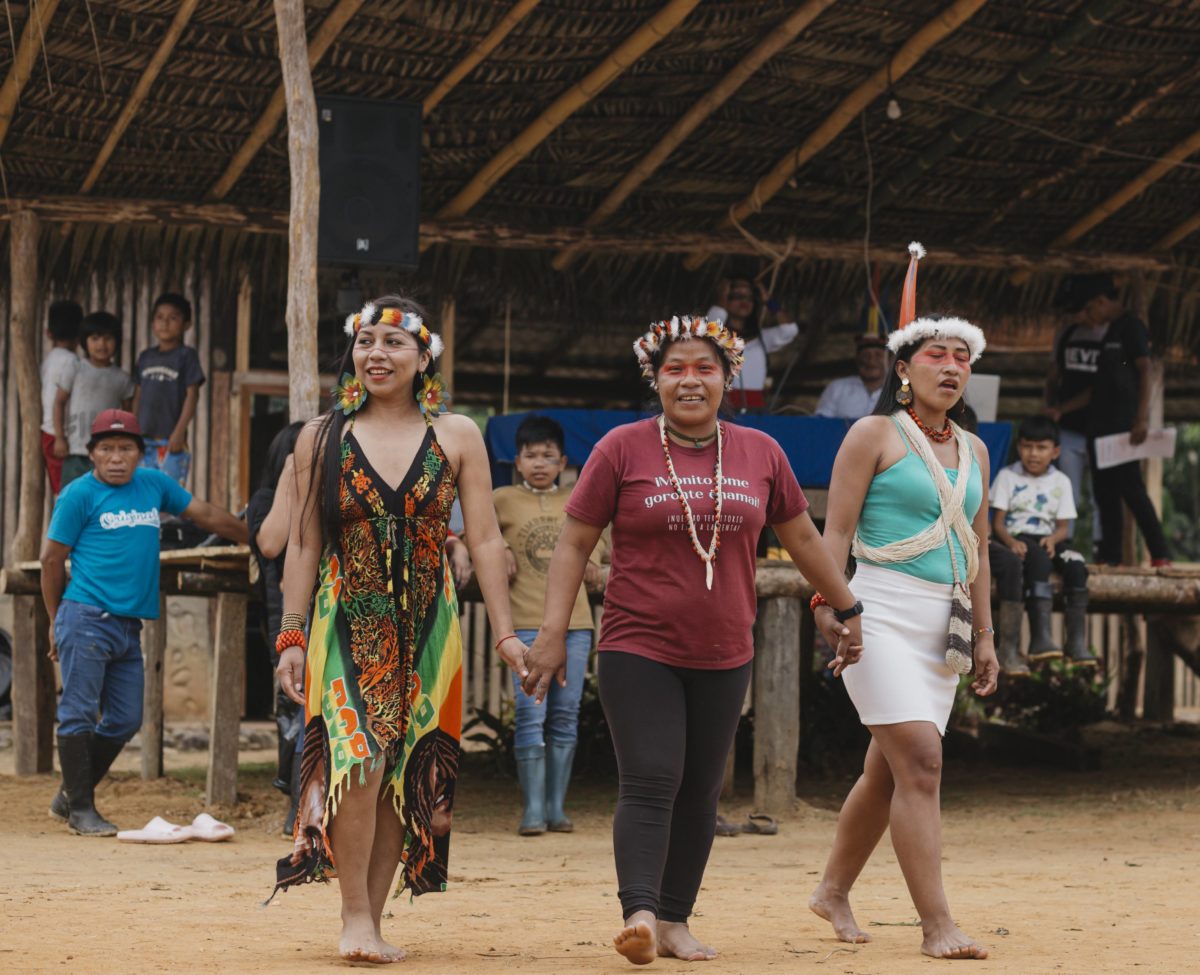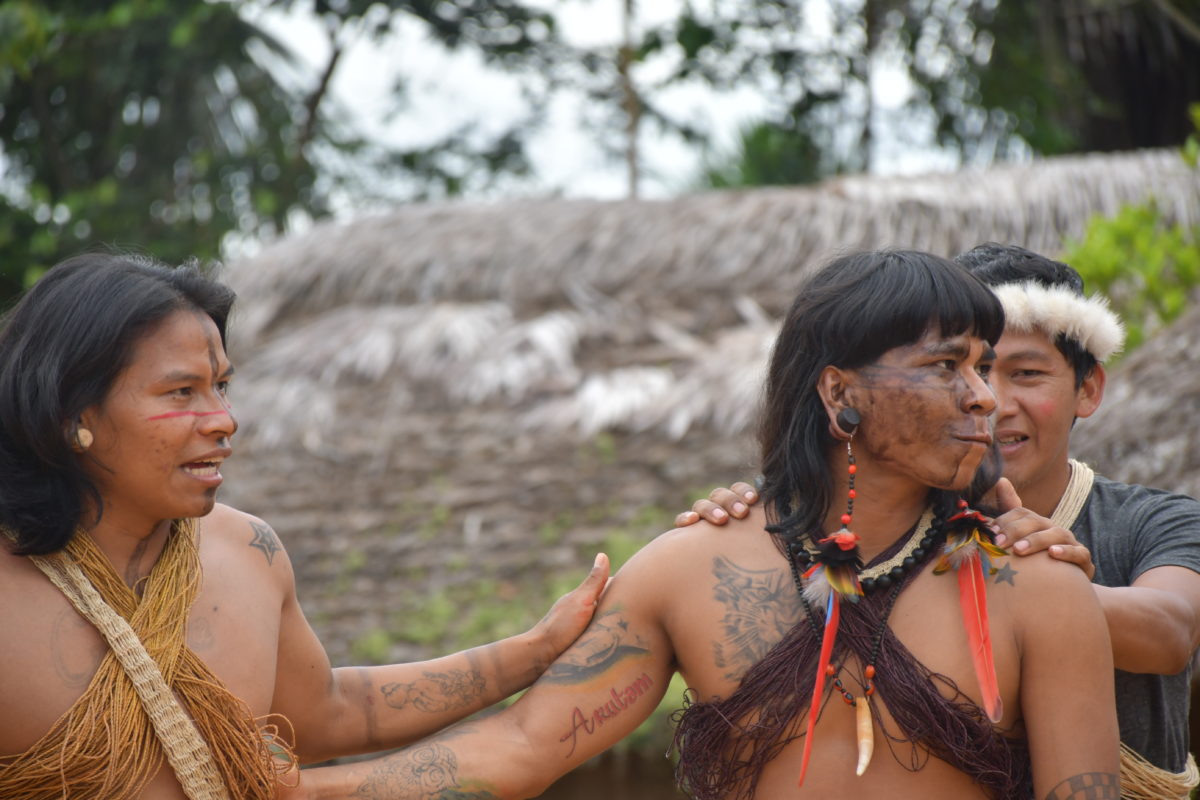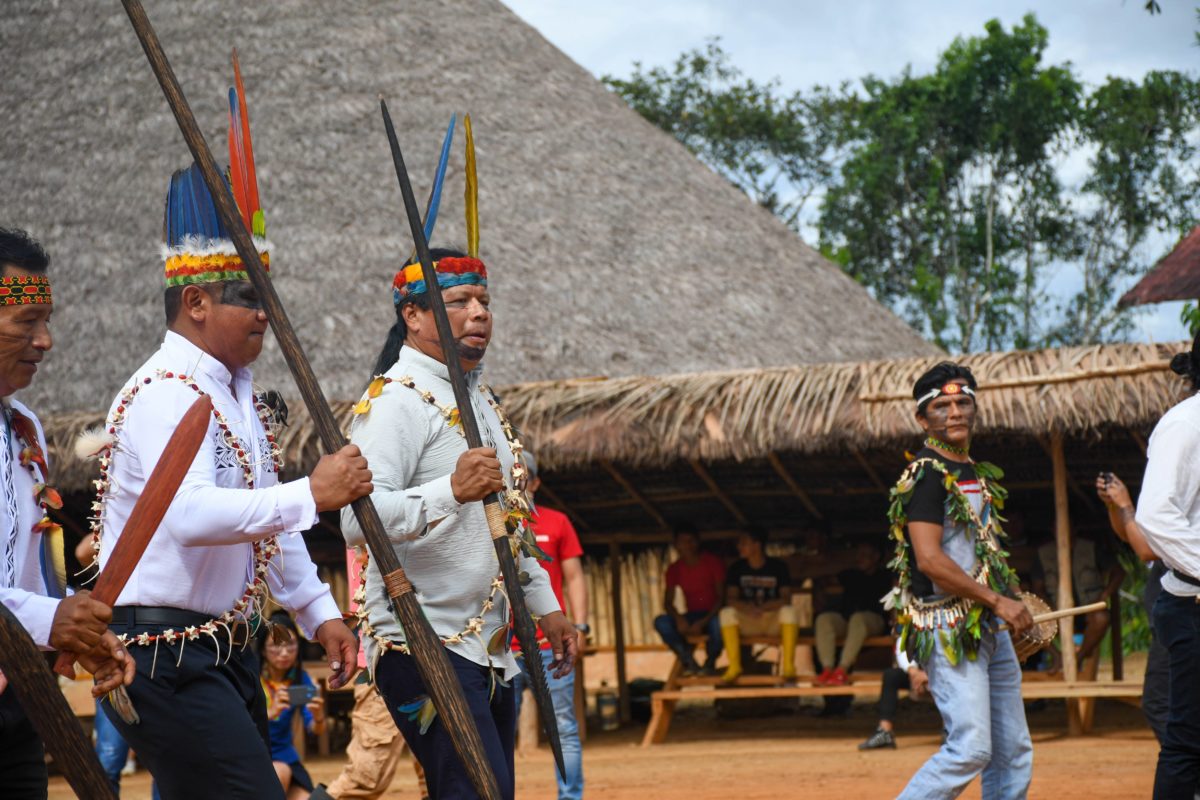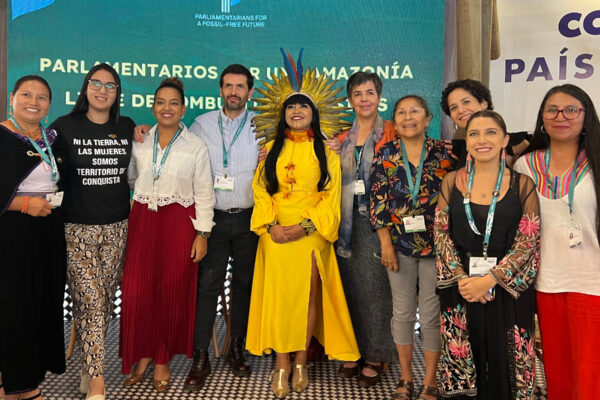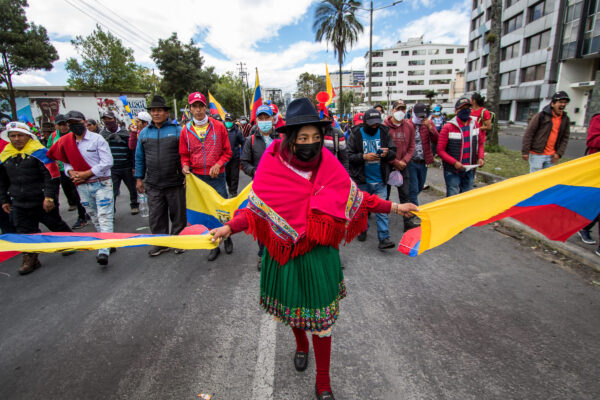This summer, as the world grappled with suffocating heat and drought, historic floods from Uganda to Kentucky, and wildfires exploding across the western U.S., a timely gathering was underway in the Ecuadorian Amazon celebrating Indigenous rights, victories, and visions for forest protection that hold the key to addressing climate change.
The Kichwa people of Sarayaku, known for their historic resistance to oil extraction and extraordinary efforts to protect their rainforest territory, convened the meeting dubbed Kawsari, which roughly translates into “awakening,” an acknowledgement of the need for a new direction in the strategies to address the climate crisis, with roots in the traditional practices of Indigenous peoples that have so successfully protected the Earth’s critical ecosystems and biodiversity for millennia.
The gathering brought together Indigenous peoples from across Ecuador, Colombia, and Peru to participate in the First Meeting of the People of the Living Forest (Primer Encuentro de los Pueblos de la Selva Viviente – Kawsak Sacha) to construct a global agreement that would strengthen Indigenous strategies of protection for “territories of life” of Indigenous peoples within the framework of the rights of nature and the self-determination of Indigenous peoples.
The Amazon Watch team joined the delegates of Indigenous nations from Ecuador, Colombia, and Peru, as well as other NGO allies and media, in the several-hour journey down the Bobonaza River by peke peke-powered canoes – a drop-in motor used when the river is low to avoid submerged rocks and logs. As the green canopy thickened as we traveled deeper into the forest, giant ceibo trees loomed in the distance, and remnants of several footbridges hung over the river, destroyed in the 2019 historic flood.
Over the three-day event, Sarayaku laid out their vision of their Living Forest proposal, celebrated their historic legal victory against the Ecuadorian government for rights violations stemming from attempts to drill for oil, and laid out their own law that defines Free, Prior, and Informed Consent in their territory.
The meeting came on the heels of an 18-day national strike led by CONAIE, Ecuador’s powerful national Indigenous confederation over cost of living increases and government plans to expand oil and mining extraction. Among other concessions, the strike forced the administration of Guillermo Lasso to rescind Decree 95, which paved the way for policy reforms to increase oil production and new exploration, and limited new mining concessions. Dialogue continues between the government and Indigenous movement to hammer out details of a peace accord that ended the uprising.
The living forest
Sarayaku’s Kawsak Sacha proposal was originally launched four years ago in Quito, and received widespread accolades as a visionary initiative. In the years since, it has gained traction in important fora, including the United Nations, IUCN, the environmental ministries of Sweden and Ecuador, ICCA, among others. The proposal was the centerpiece of the Equator Prize’s award to Sarayaku in 2021. On the ground in Ecuador, Sarayaku’s neighboring communities are adopting the Kawsak Sacha model, with more than 1.4 million hectares part of the Living Forest.
The Kawsak Sacha proposal aims to sustainably preserve and conserve territorial spaces, the material and spiritual relationship established there by native peoples with the living forest and the beings that inhabit it. “The proposal is a strategic, political, and legal platform that upholds the traditional rights of original peoples. It is the way we conceive the world in which we live – recognizing Kawsak Sacha as a conscious, living being, and subject of rights.”
The proposal also implicitly exposes what the world has gotten wrong about “conservation.” As Sarayaku fought to defend its territory from oil extraction, they also looked for ways to bolster legal protections for lands. But in Ecuador, nor elsewhere, was there a category that actually recognized their relationship with their territory.
“We found that the categories and policies that governed protection weren’t applicable to the way in which we – and most other Indigenous peoples – actually live. It ignores the symbiotic nature of relationship and coexistence that we have with our forests, our rivers, and our territory which has guided in practice our successful management for millenia,” explained Jose Gualinga, one of the intellectual architects of the proposal.
Sarayaku rightly saw that traditional conversation schemes not only often ignored the rights of Indigenous peoples, but were less effective at protecting areas than their traditional practices. Throughout the Kawsari, during official presentations, over early morning guayusa, or around the evening fire, representatives of the Achuar, Sapara, Shiwiar, Waorani, Shuar, and other Indigenous nations shared their own traditional strategies for territorial defense and management and their cosmovision of relationship with nature. Now that science has finally caught up with the effectiveness of traditional Indigenous forest and territorial management, it’s time that a category exists to recognize this relationship.
Historic resistance
Sarayaku is home to roughly 2,000 people spread over eight communities and 330,000 acres of rainforest deep in Ecuador’s Amazon. In the late 1990s, the Ecuadorian government granted an oil concession to the Argentine company CGC for oil drilling on Sarayaku territory without their consultation or consent. Faced with opposition from the community, the government militarized Sarayaku territory to allow CGC to begin oil activities and terrorized the community. The company began seismic testing in some of the most sacred areas of Sarayaku territory. Several leaders were detained and tortured by the military at a company facility, and women were raped.
But Sarayaku waged a successful, peaceful campaign to force the military and oil company off their lands and keep the estimated 100 million barrels of crude in the ground. In 2003, they filed a groundbreaking legal case against the Ecuadorian government for rights violations before the Inter-American Commission on Human Rights.
Precedent-setting legal victory
A major focus of the three-day gathering in Sarayaku was to mark the 10th anniversary of the communities of the landmark case against the Ecuadorian government. On June 27, 2012, the Inter-American Court of Human Rights determined that the Ecuadorian government was responsible for the violation of the rights to territory, cultural identity, and the right to consultation of the Kichwa people of Sarayaku. Since the 1990s, the government has granted concessions and authorized oil activities on their ancestral lands without respecting their right to consultation.
This ruling is emblematic for Ecuador and the region because, among other reasons, it established the minimum safeguards that must be met to guarantee the right to consultation. The consultation process must be: a) prior to any decision; b) in good faith and with the purpose of reaching an agreement; c) adequate and accessible from the cultural perspective of each people; d) have prior social and environmental impact studies; e) informed, that is, to inform the peoples of the possible risks of the proposed development or investment plan, including environmental and health risks.
In addition, the Court explicitly established that this obligation corresponds to the government – and not to the companies – and must be guaranteed from the first stages of the development or planning of the projects.
However, despite this triumph, in 2012 the sentence has not been fully implemented. The government has still not removed 1400 kg of pentolite – a dangerous explosive used during the seismic testing phase of oil exploration – from Sarayaku territory, and it has not adopted measures to guarantee that the right to consultation of this and all peoples is respected. The recent Sinangoe case before the country’s Constitutional Court has defined that the consultation process must lead to consent.
During the Kawsari event, Sarayaku President Tupac Amaru Viteri pointed out that there is no guarantee of non-repetition of the violations if the sentence is not fully implemented, which could put Sarayaku at risk in the future.
Strategy sharing
Complementing the presence of many Indigenous nationalities from around the Ecuadorian Amazon, elected leaders from Colombia’s U’wa people and Peru’s Achuar were also able to participate in Kawsari. The gathering was an international meeting of representatives from long-term community struggles that share many commonalities with Sarayaku. In some cases, they have fended off the same international oil companies, such as Occidental and Conoco-Phillips.
They also share some strategies, including the use of the Inter-American Human Rights system as part of their holistic approaches to defending their ancestral territories. Whereas Sarayaku is celebrating ten years of their important case before the Inter-American Court, the U’wa will be going to the Court soon as the first Colombian Indigenous People to bring their case there. The Achuar are also starting the process, taking their demands for the legal recognition of their ancestral territories before the Inter-American Commission, in Washington, D.C.
Sovereign FPIC law
A critical element to these successful strategies is the respect for their collective rights to their territory, self-determination, and consent. With the lack of an FPIC law in Ecuador and widespread violations of the right to consent regarding projects and policies slated for their lands, Sarayaku is again forging the way.
Under the heat of the noonday sun, the community presented their own law on the exercise of the right to Prior, Free and Informed Consent, that, as an autonomous nation, they will apply in their territory. The “Proper Law for the exercise of self-determination in the application of the right to free, prior, and informed consent” is a manifestation of the implementation of their right to self-determination, since it is the result of an internal and assembly reflection process that began in 2020. (Sarayaku, “Ley Propia….”, p. 8. )
With this law, Sarayaku seeks to establish its own guidelines regarding how consultation processes should be carried out in its territory in accordance with its worldview and philosophy, that is, in accordance with the Kawsak Sacha. In addition, the law states that consent is a mechanism for democratic and intercultural dialogue in the construction of a multinational state. (Sarayaku, “Proper Law…”, p. 8 and 25).
The Sarayaku consent law states that any governmental or non-governmental program or decision must have the participation, informed opinion, and consent of the Indigenous peoples (art. 5 of the law); observe the life plan (art. 7 of the law) and the declaration of Kawsak Sacha made in 2018 (art. 13); among others. Likewise, it established that there is no consent for any hydrocarbon activities, mineral extraction, large-scale logging for commercial purposes, biopiracy, and water exploitation for commercial purposes” (art. 16). These extractive activities are not subject to the FPIC process – they are strictly prohibited.
So while the world continues to drag its feet on real climate action, Indigenous peoples like those gathered at the Kawsari that bear the least responsibility for climate change and are the most vulnerable to its impacts, are the ones leading the way. It’s time that the world listened.
¡Que viva Kawsak Sacha! ¡Que viva Sarayaku!


